plum finger gall mite
(Eriophyes emarginatae)
Conservation • Description • Habitat • Biology • Distribution • Taxonomy
|
|
|||||||||||||
Description |
Eriophyid mites (Eriophyes spp.) are so small that they are almost impossible to see with the naked eye. Unless a scanning electron microscope is available, a morphological description of an adult individual is useless. The mite is most easily identified by the shape of the gall it produces and the plant species on which it is found. An infestation may be unsightly, but the damage caused by this mite is merely cosmetic. The plant is not significantly harmed. Plum finger gall mite is a specialized plant feeder. In Minnesota it can be found on American plum, chokecherry, and European plum. In other areas it also infests bitter cherry, Klamath plum, and wild goose plum. The pouch-type finger galls appear on the upper side of a leaf. They are solitary, though there are usually many galls on a single leaf. They are randomly scattered on the surface of the leaf blade. The galls are variable in length, thicker at the tip than at the base (club shaped), and erect or leaning at an angle to the leaf surface. They are green to yellowish at first, often reddish near the base, eventually turning brown. |
Size |
Tiny, almost microscopic |
Similar Species |
This is the only species that causes finger galls on the hosts listed below. It is not found on other plant species, and other mite species do not produce finger galls on these plants.. |
Habitat |
American plum, chokecherry, European plum, bitter cherry, Klamath plum, and wild goose plum |
Biology |
Season |
One generation per year. The first galls develop April to July. |
Behavior |
|
Life Cycle |
The female overwinters in a crevice of a bud near the base of a branch. It emerges in the spring and seeks a newly developing leaf. As it feeds on the leaf, a chemical in its saliva causes the leaf cell to expand, forming a pouch. It then enters the pouch, lays 50 to 60 eggs, and dies. In late spring the eggs hatch, producing males and females that remain in the pouch throughout the summer. Another eriophyid mite, Eriophyes prunidemissae, is normally found on the same branch. It overwinters in the buds at the tip and near the tip of the branch. It has two generations per year. The second generation invades the galls of the chokecherry finger gall mite. At the end of the season, when the gall splits open and releases the mites, Eriophyes prunidemissae outnumbers the chokecherry finger gall mite. |
Food |
In Minnesota, leaves of American plum, chokecherry, and European plum. |
Distribution |
||
|
Sources |
|
| 5/25/2025 | ||
Occurrence |
||
Common |
||
Taxonomy |
|
| Class | Arachnida (Arachnids) |
| Subclass | Acari (mites and ticks) |
| Order | Acariformes (mites) |
Superfamily |
Eriophyoidea |
Family |
Eriophyidae (gall and rust mites) |
Subfamily |
Eriophyinae |
Tribe |
Eriophyini |
Genus |
Eriophyes |
Order |
|
Subordinate Taxa |
|
|
|
Synonyms |
|
Phytoptus emarginatae |
|
Common Names |
|
bitter cherry gall mite chokecherry finger gall mite plum finger gall mite plum leaf gall mite Prunus finger gall mite |
|
Visitor Photos |
||
Share your photo of this arachnid. |
||
This button not working for you? |
||
Luciearl |
||
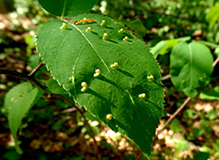 |
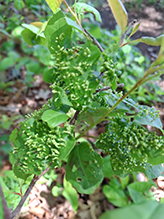 |
|
TC |
||
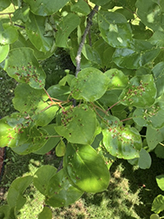 |
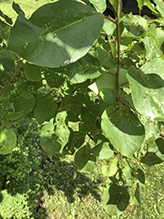 |
|
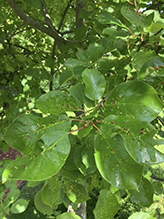 |
||
MinnesotaSeasons.com Photos |
||
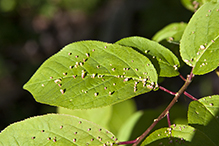 |
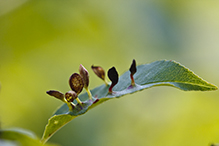 |

Slideshows |
|

Visitor Videos |
||
Share your video of this arachnid. |
||
This button not working for you? |
||
|
Other Videos |
||
|

Visitor Sightings |
||
Report a sighting of this arachnid. |
||
This button not working for you? |
||
Luciearl |
Location: Fairview Twp. |
 |
Luciearl |
Location: Cass County |
 |
| TC 7/10/2022 |
Location: Charlottetown, Prince Edward Island, Canada |
 |
Mark Hager |
Location: 21 miles north of Grand Rapids. |
|
| mhughes 6/9/2015 |
Location: Duluth prolific infestation on one of five trees |
|
| Izzaroo 6/4/2015 |
Location: Walker, MN - near Chippewa Nat Forest We just discovered them today! |
|
| Doug H. 5/13/2015 |
Location: Chokecherry bush in my back yard, Hopkins, MN the bush appears to be covered with these galls. |
|
MinnesotaSeasons.com Sightings |
||

Created: 5/19/2012 Last Updated: © MinnesotaSeasons.com. All rights reserved. |
